Your sun oven can help you prepare seven delicious make-ahead meals while saving energy. Start with protein-rich Dal Bhat, which combines lentils and rice for multiple servings. Create a versatile baked potato base that you'll transform into different dishes throughout the week. Cook a Mediterranean seafood feast featuring cod, shrimp, and shellfish in one pot. Don't forget summer fruit preserves for year-round enjoyment. You'll also want to prepare staples like pre-cooked grains and roasted vegetables that last 5-7 days. With proper storage techniques and airtight containers, you'll maximize your sun oven's potential to revolutionize your weekly meal planning. Let's explore these solar-powered recipes in detail.
Essential Sun Oven Batch Cooking
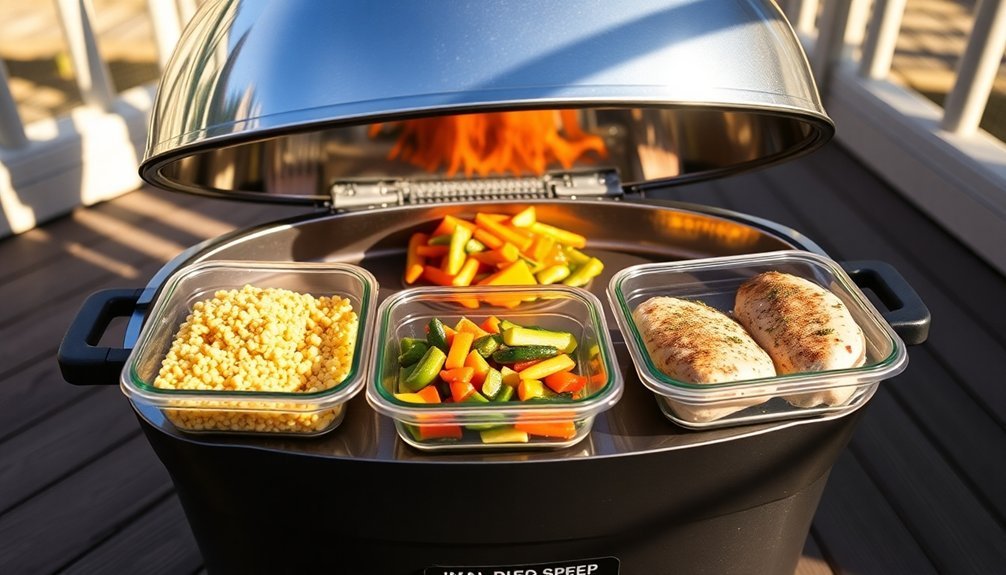
When you're ready to maximize your Sun Oven's potential, batch cooking becomes an essential skill for efficient meal preparation.
Start by preheating your oven for 20-30 minutes until it reaches 300°F, using the alignment holes to position it correctly with the sun. You'll need to adjust the oven's position every 30 minutes for ideal heat. Place the dual-purpose leveling rack for airflow around your cookware for optimal heat distribution.
Choose dark enamelware pots for best results, and plan your cooking schedule around peak sun hours. You can cook multiple dishes throughout the day at different time slots – perhaps beans at 10am, bread at 1pm, and a casserole at 3pm.
Remember to reduce liquid amounts by 1/4 to 1/2 cup since there's less evaporation, and leave a small airspace in containers to let moisture escape. For consistent results, use smaller containers and don't forget your oven mitts when handling hot cookware.
Dal Bhat For Multiple Meals
You'll find Dal Bhat to be an ideal make-ahead meal, combining protein-rich lentils with rice in a hearty one-pot preparation that's perfect for your Sun Oven.
Your batch can easily feed a family for several days when you store the lentils and rice separately in airtight containers in the refrigerator. Many Nepali households traditionally consume this nutritious dish twice daily.
While the basic recipe serves as your foundation, you're free to mix up the accompaniments throughout the week, from fresh curried vegetables to homemade chutneys, keeping each meal interesting and nutritious.
Hearty One-Pot Preparation
Creating hearty dal bhat in your Sun Oven offers a perfect solution for multiple make-ahead meals while maximizing energy efficiency.
You'll need one cup of yellow lentils or 1.5 cups of peas, combined with aromatics like chopped onion, garlic, and ginger. Add your spices – turmeric, cumin, coriander, and garam masala – along with 3-5 cups of water depending on your desired consistency. During preparation, incorporating fresh cilantro leaves adds an authentic finishing touch.
Layer your ingredients in the preheated Sun Oven, which should reach 325-350°F. Stack the dal pot with your rice pot and let them cook for 8 hours, realigning every 30 minutes to maintain temperature.
Pre-soaking your lentils for 4-8 hours will improve digestibility and reduce cooking time. This recipe serves 4-5 people and stores well for future meals.
Adaptable Storage Tips
To maximize your Sun Oven's dal bhat preparation, proper storage techniques will help preserve multiple meals for future use. Store your ingredients in dark, cool spaces between 40°F to 50°F, and use oxygen absorbers to maintain freshness. When storing bulk quantities, you'll want to repackage them with clear dating labels. Using a solar cooking method allows you to prepare meals sustainably while reducing reliance on traditional fuel sources.
| Storage Type | Temperature | Protection Needed |
|---|---|---|
| Dry Lentils | 40-50°F | Oxygen Absorbers |
| Spices | 40-50°F | Dark Containers |
| Cooked Dal | Below 40°F | Airtight Seals |
For your prepared dal bhat, portion the meals into airtight containers and refrigerate what you'll eat within three days. Freeze the remaining portions for up to three months. Remember to rotate your stored ingredients regularly, using the oldest items first to prevent waste.
Solar Baked Potato Base Dishes
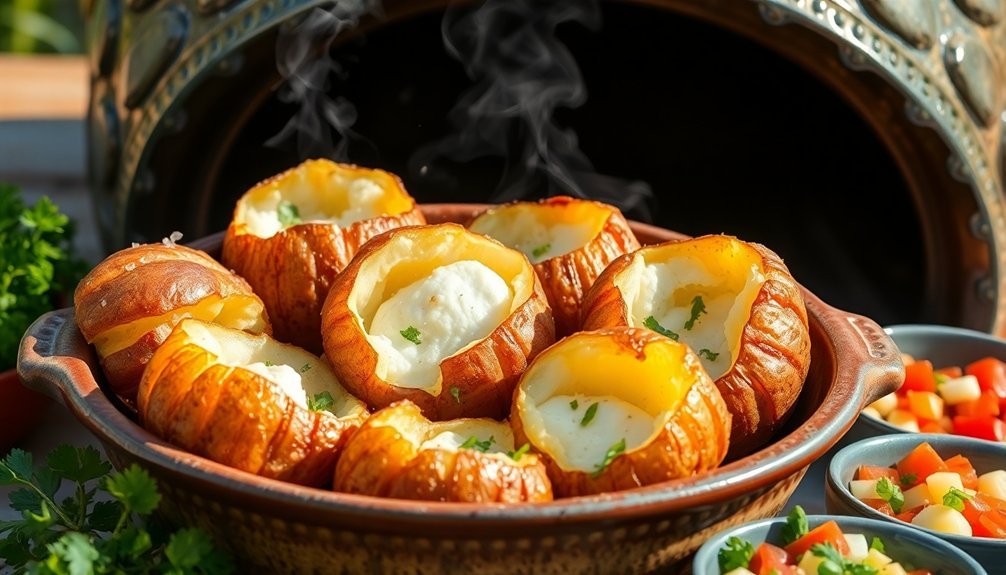
You can transform solar-baked potatoes and sweet potatoes into versatile meal bases by setting up a DIY toppings bar with your favorite herbs, proteins, and condiments.
For efficient batch cooking, you'll want to slice your potatoes thinly and arrange them in dark pots with bouillon to guarantee even cooking and moisture retention.
Store your cooked potato dishes in airtight containers for up to 4 days, keeping toppings separate until serving to maintain freshness and prevent sogginess.
Customize Your Toppings Bar
Once your sun-baked potatoes are ready, setting up a versatile toppings bar lets everyone customize their meal to their tastes.
Start with classic options like butter slices, sour cream, shredded cheese, crispy bacon, and sliced green onions. These traditional toppings create a familiar comfort food experience.
For a Mexican-inspired twist, offer salsa, minced cilantro, pickled jalapeños, black olives, and lime wedges. You'll transform your basic potato into a zesty, south-of-the-border treat.
If you're looking for healthier alternatives, consider roasted broccoli, black beans, diced avocado, or sautéed peppers and onions. You can also add roasted cauliflower, cherry tomatoes, or kale chips for extra nutrition and variety.
Mix and match toppings from different categories to create unique flavor combinations.
Batch Cook Storage Tips
After preparing multiple batches of solar-baked potato dishes, proper storage becomes essential for maintaining freshness and flavor throughout the week.
You'll want to cool your dishes completely before transferring them to storage containers to prevent condensation and sogginess.
For best results when storing your solar-cooked potato dishes:
- Transfer cooled potato dishes to airtight containers, guaranteeing a proper seal to maintain freshness.
- Refrigerate immediately after cooling, especially for dishes like potato salad that contain perishable ingredients.
- Consider portioning meals into individual servings before storage to make reheating more efficient.
- Label containers with cooking dates and contents for easy meal planning.
If you need to reheat your dishes, you can use your sun oven again, monitoring the temperature with the built-in thermometer to confirm proper warming without overcooking.
One-Pot Mediterranean Seafood Feast
Creating a delectable Mediterranean seafood feast in your sun oven transforms an ordinary meal into a spectacular dining experience.
Begin by preheating your sun oven for an hour while you prepare the seafood. Use black, non-reflective cookware to maximize heat retention.
Start by sautéing onions, garlic, and celery in olive oil. Add your broths, wine, and vermouth mixture infused with saffron.
Layer in the cod fillets first, followed by shrimp, squid, and shellfish. You'll need to stir the liquid components every 10 minutes and rotate solid ingredients for even cooking.
Position your sun oven to track direct sunlight, especially during peak hours. Monitor internal temperatures carefully, and adjust cooking times based on sunlight conditions.
Remember to use protective gear when handling hot cookware, and keep the vessel covered to trap heat effectively.
Summer Fruit Dessert Preserves
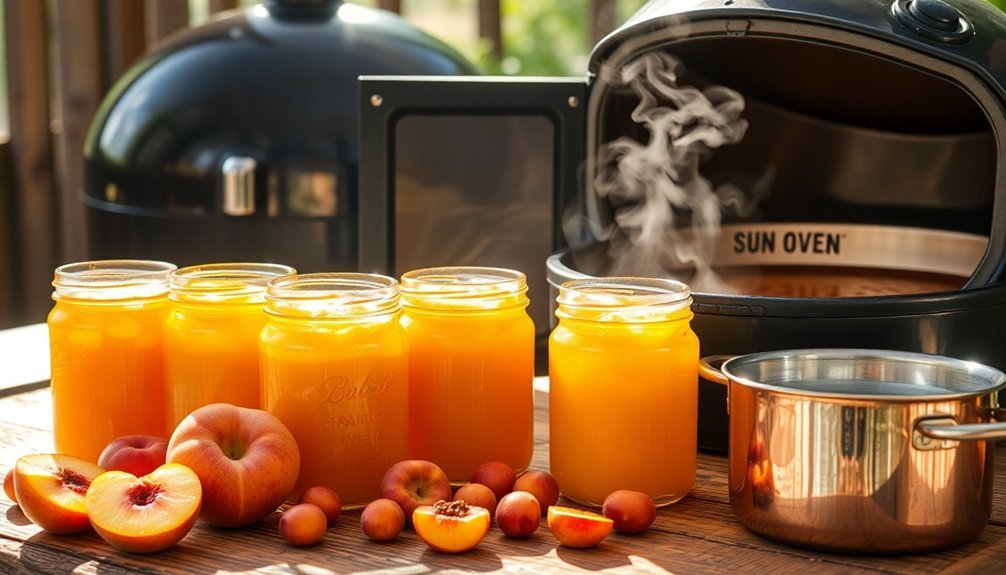
The sun oven provides a perfect way to make four delightful summer fruit preserves while conserving energy.
You'll love how easily these preserves capture summer's sweetness using natural heat. From fragrant fig jam with rosemary to blueberry compote with thyme, each recipe offers unique flavor combinations.
- Create fig jam using maple sugar and fresh lemon juice, perfect for breakfast spreads.
- Combine strawberries and peaches into a versatile compote for yogurt or overnight oats.
- Cook down fresh cherries into a rich syrup that's ideal for multiple breakfast dishes.
- Mix blueberries with brown sugar, lemon, and thyme for a sophisticated preserve.
You can freeze these preserves for up to six months or use traditional water bath canning for longer storage.
Each preserve lets you enjoy summer fruits year-round while saving on energy costs.
Make-Ahead Solar Oven Staples
Savvy solar chefs know that preparing staples ahead of time maximizes their sun oven's efficiency. You'll want to focus on items that store well and serve as foundations for future meals.
| Staple Item | Cooking Method | Storage Time |
|---|---|---|
| Bread Rolls | Dark glass pan, 3 hrs at 250°F | 3-4 days |
| Roasted Vegetables | Lidded dark dish, own juices | 5-7 days |
| Marinated Meats | Cast iron pot with rack | 3-4 days |
| Baked Potatoes | Oil-rubbed, lidded pot | 5-7 days |
| Ratatouille | Dark glass dish, no water | 4-5 days |
Remember to use your thermometer and refocus your oven every 30 minutes while preparing these basics. Keep lids on tight and opt for dark cookware to maintain consistent temperatures. You'll build a useful stockpile of ingredients ready for quick meal assembly throughout the week.
Quick Solar Meal Prep Tips
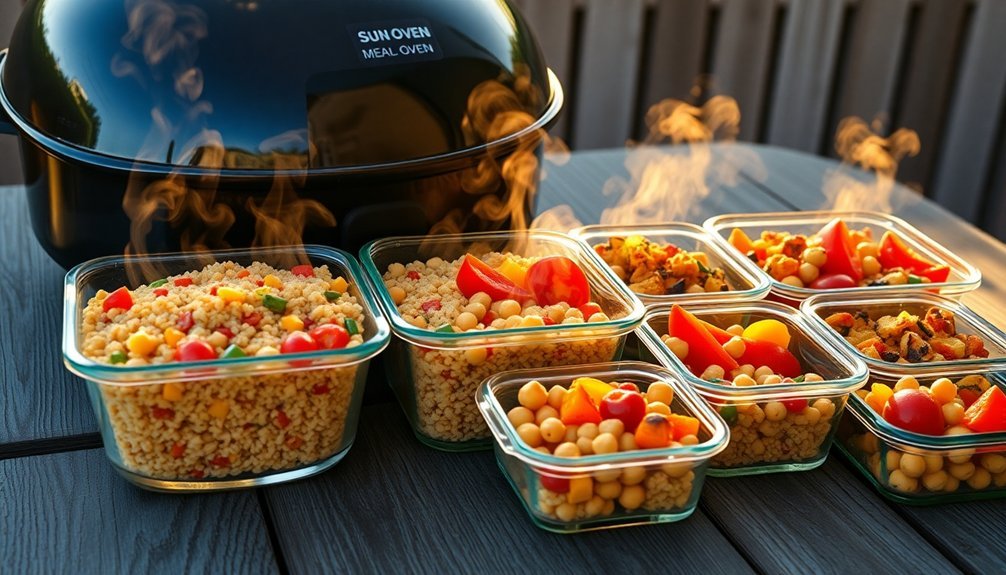
Four essential tips make solar meal prep both efficient and successful. When you're planning your sun-cooked meals, efficiency is key to maximizing your cooking time and ensuring delicious results.
- Pre-heat your solar oven to at least 200°F before adding food, and position it to capture maximum sunlight.
- Choose dark-colored cookware like cast iron or granite ware, or wrap glass dishes in dark towels for better heat absorption.
- Keep ingredients simple and quick-cooking – cookies, biscuits, and vegetables work perfectly.
- Plan to refocus your oven every 30 minutes to maintain ideal temperature.
Remember to keep your recipes uncomplicated and use lids to trap heat.
For best results, combine ingredients that cook at similar temperatures, and don't open the oven unnecessarily during cooking to maintain consistent heat.
Frequently Asked Questions
How Long Can Solar-Cooked Meals Safely Stay in a Thermos Container?
You can safely keep your solar-cooked meals in a well-insulated thermos container for several hours. Make sure you're using proper containers and monitoring food temperature to maintain food safety standards.
Can You Stack Multiple Dishes in a Solar Oven Simultaneously?
Yes, you can stack multiple dishes in certain solar ovens like the Sun Oven and SunTaste 200 XL. You'll need stackable pots and careful arrangement to guarantee proper heat distribution and cooking efficiency.
Which Containers Work Best for Freezing Solar-Cooked Meals?
You'll get best results with tempered glass containers and freezer-safe BPA-free plastic. Leave 3/4 inch headspace for expansion, and make certain containers have tight-fitting lids to prevent freezer burn and maintain freshness.
Does Altitude Affect Solar Cooking Times for Make-Ahead Meals?
Yes, altitude affects your solar cooking times considerably. You'll need more liquid and longer cooking times at higher elevations, but you'll also benefit from stronger solar radiation, which can help offset these increases.
How Do Cloudy Days Impact the Reheating of Pre-Cooked Solar Meals?
You'll find that cloudy days considerably slow down reheating times for pre-cooked meals. Your food won't heat evenly, and you might need to extend warming times or switch to conventional heating methods instead.
In Summary
You'll save time and energy by preparing these seven make-ahead sun oven meals. Whether you're batch cooking dal bhat, baking potatoes, or preserving summer fruits, your solar cooker lets you harness free energy while creating delicious, sustainable food. Start with these essential recipes and you'll discover how easy it is to build a week's worth of meals using nothing but sunshine and simple ingredients.

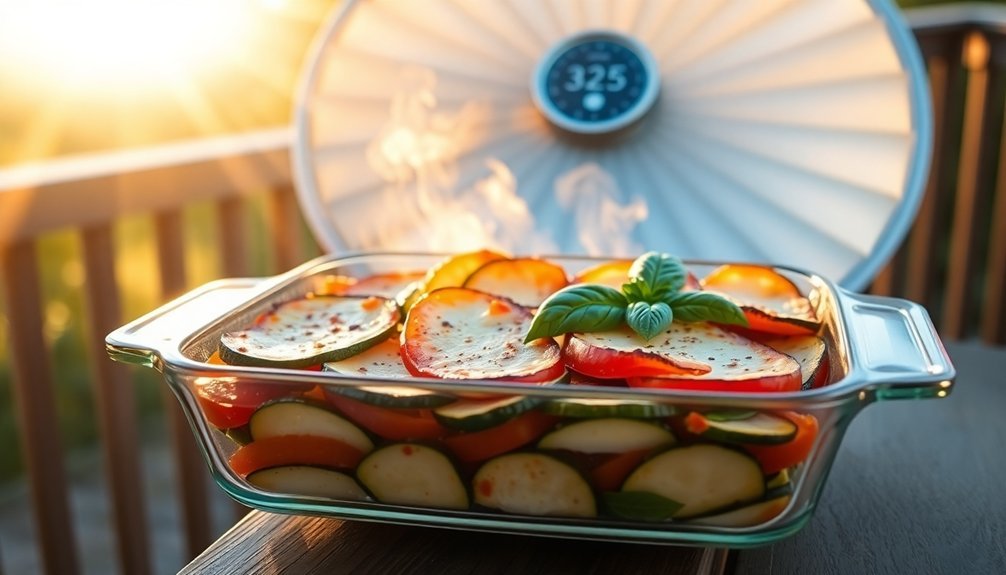


Leave a Reply